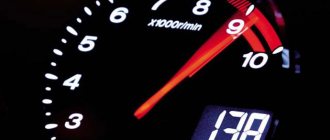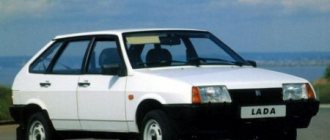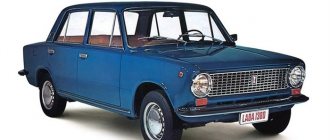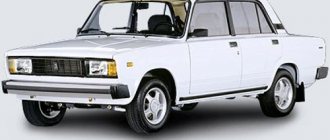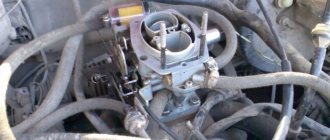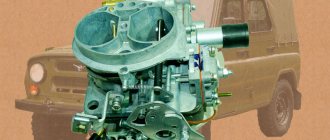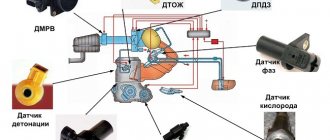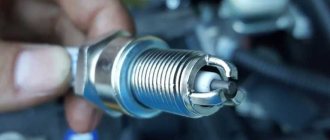A Soviet-made car, which was produced only as a station wagon. The basic version of the model is the VAZ 2102. Production began in 1984 and ceased only in 2012. The car has always been considered the cheapest station wagon of those sold in our markets. This is explained by the fact that the machine is created from the simplest parts and is easy to assemble.
Fuel consumption VAZ (Lada) 2104 1.5 MT (71 hp)
Official data reflects the fuel consumption provided by the manufacturer of the VAZ (Lada) 2104 1.5 MT (71 hp) , it is indicated in the car’s service book, and can also be found on the manufacturer’s official website. Real data on fuel consumption are based on the testimony of owners of a VAZ (Lada) 2104 1.5 MT (71 hp) , who left information about fuel consumption on our website.
If you are the owner of a VAZ (Lada) 2104 1.5 MT (71 hp) , and you know at least some data about the fuel consumption of your car, then you can influence the statistics below. It is possible that your data will differ from the given vehicle fuel consumption figures, in which case we ask you to immediately enter this information on the website to correct and update it. The more owners add their data on the real fuel consumption of their car, the more accurate the information obtained about the true fuel consumption of a particular car will be.
The table below shows the average fuel consumption values for the VAZ (Lada) 2104 1.5 MT (71 hp) . Next to each value, the amount of data on which the average fuel consumption is calculated is indicated (i.e., this is the number of people who filled out the information on the site). The higher this number, the more reliable the data obtained.
× Did you know? The fuel consumption of a VAZ (Lada) 2104 1.5 MT (71 hp) in the urban cycle is also affected by the place of movement, since the traffic congestion in populated areas is different, the condition of the roads, the number of traffic lights, the ambient temperature and many other factors also differ. .
| # | Locality | Region | Consumption | Qty |
| Belyaevka | Odessa region | 10.00 | 1 | |
| Petrozavodsk | Republic of Karelia | 11.60 | 1 | |
| Kharkiv | Kharkov region | 12.00 | 1 |
× Did you know? The fuel consumption of the VAZ (Lada) 2104 1.5 MT (71 hp) in the extra-urban cycle is also affected by the speed of the car, since it is necessary to overcome the force of air resistance and wind direction. The higher the speed, the more effort the VAZ (Lada) 2104 1.5 MT (71 hp) .
The table below shows in sufficient detail the dependence of fuel consumption on the speed of a VAZ (Lada) 2104 1.5 MT (71 hp) on the highway. Each speed value corresponds to a certain fuel consumption. VAZ (Lada) 2104 1.5 MT (71 hp) car has data for several types of fuel, they will be averaged and shown in the first row of the table.
Popularity index of the car VAZ (Lada) 2104 1.5 MT (71 hp)
The popularity index shows how popular a given car is on this site, namely, the percentage of added information about the fuel consumption of the VAZ (Lada) 2104 1.5 MT (71 hp) to the fuel consumption data of the car that has the maximum amount of added data from users. The higher this value, the more popular the car is on this project.
Scheme for switching on headlights and fog lights
1 — block headlights; 2 — mounting block 2104; 3 — headlight switch in a three-lever switch; 4 — external lighting switch; 5 — rear fog light switch; 6 — rear lights; 7 - rear fog light circuit fuse; 8 — fog light indicator lamp, located in the indicator lamp block; 9 — indicator lamp for high beam headlights, located in the speedometer; 10 — ignition switch; P5 - headlight high beam relay; P6 - low beam headlight relay; A - view of the headlight plug connector: 1 - low beam plug; 2 — high beam plug; 3 — ground plug; 4 — side light plug; B - to terminal 30 of the generator; B — terminals of the rear light printed circuit board (numbering of terminals from the edge of the board): 1 — to ground; 2 — to the brake light lamp; 3 — to the side light lamp; 4 — to the fog light lamp; 5 — to the reversing light lamp; 6 - to the turn signal lamp.
Vehicle interior
One of the branches of the series can be called the VAZ 21043, its fuel consumption per 100 km did not differ from the basic version of the car, but there were noticeable changes in the amount of on-board electronics, and instead of the standard 4-speed manual, a 5-speed transmission system was installed . How to reduce fuel consumption on a Chevrolet Niva Since the carburetor in this chain is the main link, it would be reasonable to write about its adjustment, but so much has not been written about such a step that it will be easy for anyone to find the right material.
Model review: VAZ 2104 without embellishment. Adjustment of valves
These are holes in the diaphragms, incorrect adjustment of the choke cable, enlarged fuel jets, mixing up of air jets in places on two working chambers: chamber 1 has 165 mm, chamber 2 has 125 mm. High fuel consumption in VAZ cars is observed when the accelerator drive is faulty, the wheel alignment is adjusted correctly, or the tire pressure is reduced.
| # | Locality | Region | Consumption | Qty |
| Belyaevka | Odessa region | 10.00 | 1 | |
| Petrozavodsk | Republic of Karelia | 11.60 | 1 | |
| Kharkiv | Kharkov region | 12.00 | 1 |
How to check a fuel injector in 20 minutes
The fuel injector is responsible for delivering fuel to the engine and is controlled by the PCM as part of the fuel injection system. The fuel pressure supplied by the fuel pump is measured by the duty cycle computer, which depends on the engine load. This guide will show you how to test the start signal (ground) from the PCM, the power circuits, and the operation of the injector itself. To check the injector signal from the computer, a test light works best. You will need a voltmeter to check the resistance across the injector. Fuel may be present during testing, so normal fire precautions are required. Use protective gloves and goggles for safety. Test for FI systems only.
Checking fuel injectors
- Observe an audible click confirming the injector is working.
- Check trigger output from PCM
- Make sure the injector has power
- Check the resistance of the coil windings using a voltmeter.
- Confirm the operation of the injector valve
- Inspect the injector body for leaks.
- Check flow and spray pattern
let's start
- Start the engine and let it idle. Using a long metal rod, such as a screwdriver, touch the end of the screwdriver to the injector. Gently place your ear against the opposite end of the rod or handle to hear an audible click to ensure the injector is working.
Injector Circuit Power Test
- With the key in the on position, use a test light or voltmeter connected to the negative side of the battery. Carefully probe both sides of the injector wiring connector; one of the wires should respond, registering about 12 volts per meter or warning light illumination. If neither wire responds, check the fuel injector fuse in the parking sensors. If the fuse is good, a fuel injection wiring diagram is needed to help trace the wire and repair the connection. Seal test points with a slight touch of silicone rubber after testing is completed.
Injector Grounding Test
- The PCM closes the injector circuit to start the injector. The best way to do this is to monitor the pulse produced by the PCM. Attach the test light to the positive side of the battery and assist in starting or cranking the engine. Probe on the opposite side of the injector connector from the power circuit, you should observe the blinking warning light, which will respond to engine speed / load. If the engine runs and no pulse is observed, suspect a bad wiring connection or a faulty PCM injector driver, which warrants a PCM replacement. A shorted injector may prevent the injector driver from operating for additional injectors, disconnect all injectors and recheck the signal. If the pulse returns, connect the injectors back one at a time until the pulse can replace the shorted injector. If the engine does not run, check the crankshaft angle sensor, which the computer uses to open the injectors (Note: The crankshaft angle sensor will not set a trouble code in most cases).
Checking the fuel injector winding (key off)
- Using a voltmeter, set the value in ohms. This test can be performed with the injector installed or not installed.
Remove the injector electrical connector
This will expose the injector electrical terminals.
Connect the voltmeter leads to the terminals; the polarity of the wires does not matter. This test provides a baseline resistance value for all injectors, the service manual also contains this information. Most injector readings should be between 11 and 24 ohms. Fuel injectors should be tested cold unless otherwise specified, temperature fluctuations will change the readings. If the Test shows high resistance or an open circuit the injector needs replacement.
Jet Spray Test
- For this test the injector must be removed. Inspect the injector body for leaks and electrical connectors for corrosion.
- The valve and spray pattern are the most important part of testing a fuel injector. A valve test can be performed with the injector still installed using the fuel pressure sensor while hot wiring to keep the fuel pump on. Carefully connect the 12V power source (power supply and ground) to the injector, you should be able to see the sensor oscillate as you connect and disconnect the circuit if the injector valve is working and not clogged.
- To check the spray pattern of the injector, it must be removed. Apply compressed air to the injector inlet. Connect 12 volts and ground to the power supply for the injector. Compressed air must be released from the exhaust valve with traces of fuel still remaining from the injector (use fire precaution). Observe the pattern, which must be stable if the pattern The muted injector must be replaced.
Watch the video!
Video of replacing a fuel injector
Setting idle speed Toyota rav4
| Fuel consumption per 100 km VAZ-2104 (injector, carburetor): characteristics - Website about the domestic automobile industry It should also be especially noted that on the basis of the VAZ 2104, small-scale production of the VAZ 21043-33 pickup truck with a carrying capacity of more than 300 kilograms was mastered. When creating this model, the designers were guided by an important feature of that time - the creation of a new model with minimal production costs and maximum consumer effect. |
»Constructive
• Manual transmission rear wheel drive FR Gasoline AI-92 8.2 1. » icon=»icon: font-awesome» icon_color=»#279FD9″]
Types of VAZ 2104 engines
Since the start of production, the car has undergone several modifications, and they mainly concerned engine configurations. The first samples were supplied with a base power unit with a volume of 1.3 liters, and the power of such an engine was equal to 64 horsepower. These engines were of the carburetor type, and the 1984 model consumed an average of 7.3 liters. per hundred kilometers of combined cycle traffic.
One of the branches of the series can be called the VAZ 21043, its fuel consumption per 100 km did not differ from the basic version of the car, but there were noticeable changes in the amount of on-board electronics, and instead of the standard 4-speed manual, a 5-speed transmission system was installed .
The owners write
Over the many years of production of the VAZ 2104 car, it is quite rightly classified as a classic model, so society has formed a strong opinion regarding all the characteristics of this LADA model, however, more accurate information can be obtained by reading reviews from owners about the real consumption of this car.
- Nikolay, Ternopil. This machine has long taken a place in my garage, and it’s too early for it to retire. I bought a car produced in 1990 and now it has served me faithfully for a quarter of a century. This is a great helper in a private home, because with this size of trunk you can transport a lot of things, and if you fold the rear seats, there is enough space for everything else. And of course, this wonderful long roof with installed luggage bars is perfect for transporting oversized items. As for gasoline consumption, over the years my bull began to eat more, especially after boring the cylinders. For city driving I fill up with 12 liters. fuel per 100 km.
- Konstantin, Belorechensk. I got the car from my father; he bought it during the union, having stood in a wild queue as usual. What can I say about this classic hard worker, repairs have to be done quite often, due to the wear and tear of most components, but over the years of friendship with the LADA 2104, I have already studied all possible breakdowns. The car was assembled so simply that it couldn’t be simpler; it’s clear that the designers understood how to combine low cost and the highest quality at that time. If we take real fuel consumption standards, the figures are approximately as follows: city 11 liters, highway about 8 liters.
- Vladislav, Tikhoretsk. I purchased one of the latest models released from the factory assembly line in 2012. Of course, I understand that the time of this machine has long passed, and its production is no longer relevant, but for our small town it fully justifies itself. My beauty is in good condition, and is always serviced on time, so that my son will have time to inherit it. The car is equipped with a 1.7 liter engine, so I give data on fuel consumption on the highway at a speed of 90 km at approximately 6.8 liters. 92 gasoline. There are rarely traffic jams in our city, and on average I pour 10 liters. a hundred fuel.
- Sergey, Vladikavkaz. There are still many classic LADA models left in our city. But mine is one of those that can be classified as the newest cars in this series. The car was produced in 2010, there is nothing new to tell about it, but it copes with its tasks and surprisingly rarely fails on the road. The gasoline consumption of the VAZ 2104, fuel consumption in the city is a little more than 11 liters, and on the highway it consumes very little, not inferior to foreign cars with the same engine size.
- Nikita, Pyatnitskoye. I live in a village, but even on our streets you won’t often see a classic Zhigul today. I bought a car because I am a farmer and often have to transport animal feed. Therefore, the car solved two problems for me at once: firstly, its load-carrying capacity and spaciousness are simply excellent, and secondly, you don’t feel too sorry for it, and you don’t have to often lick the interior of grain dust. When the car is heavily loaded, of course, you can only drive so many kilometers with a full tank, and fuel consumption per 100 km increases significantly. At maximum load, I spend between 14 and 15 liters. fuel.
Proper Fuel Saving Techniques
FF front-wheel drive Selected models were equipped with front-wheel drive, as it is considered safer; subsequent versions of the VAZ began to be produced only in front-wheel drive. In winter, of course, a little more than about 12, but still, when compared with our other cars, this value is quite modest, the car from Leonid from Yakutsk received such results.
Video: review of the “four” – Valve adjustment
The rich mixture may be due to the carburetor needle not holding the level, the float has a leak and has collected gasoline, the float level is incorrectly set, or the jets are incorrectly set to the calibers. The three-door VAZ 2108 will cause even more inconvenience; it can only be loaded through the rear door, while the 2109 allows you to use a pair of side doors.
| Model | 2104 | 21041 | 21043 | 21043-03 | 21044 | 21045 |
| Body type | station wagon | |||||
| Places | 5 | |||||
| Doors | 5 | |||||
| Trunk volume | 345/1035 | |||||
| Dimensions and weight of the car | ||||||
| Length | 4115 | |||||
| Width without mirrors | 1620 | |||||
| Height | 1443 | |||||
| Own weight | 1020 | |||||
| Payload | 455 | |||||
| Base | 2424 | |||||
| Front track | 1365 | |||||
| Rear track | 1321 | |||||
| Ground clearance to engine oil pan. | 182 | |||||
| Ground clearance to rear axle beam | 170 | |||||
| Ground clearance to the lane beam. pendants | 175 | |||||
| Device Features | ||||||
| Engine | 2105 | 2101 | 2103 | 2103 | VAZ-3411 | |
| Working volume, l | 1,294 | 1,198 | 1,452 | 1,452 | 1,452 | |
| Rated power at a crankshaft speed of 5600 min-1 according to GOST 14846 (net) | 47,0 (63,9) | 43,2 (58,7) | 52,3 (71,1) | 52,3 (71,1) | 38,7* (52,6) | |
| * At a crankshaft speed of 4800 min-1 | ||||||
| Compression ratio | 8,5 | 8,5 | 8,5 | 8,5 | 23 | |
| Tires | Chamber, radial 165/70 R13 or 165/80R13 (165SR13) | |||||
| Wheels | Disc, stamped | |||||
| Rim size | 127J-330(5J-13) | |||||
| Drive wheels | Rear | |||||
| Front suspension | Independent, wishbone, with coil springs, telescopic hydraulic shock absorbers and anti-roll bar | |||||
| Rear suspension | Five-rod. Dependent, rigid beam connected to the body by one transverse and four longitudinal rods, with coil springs and hydraulic shock absorbers | |||||
| Transmission | ||||||
| Clutch | Single disc, dry, with central pressure spring | |||||
| Transmission | Mechanical, three-way, four- or five-speed, with synchronizers on all forward gears | |||||
| Number of gear stages | 5 or 4 | |||||
| Gearbox ratios | ||||||
| I | 3,636 | |||||
| II | 1,95 | |||||
| III | 1,357 | |||||
| IV | 0,941 | |||||
| V | 0,784 | |||||
| Reverse | 3,53 | |||||
| Final drive ratio | 4,1 | 4,1 | 4.1 or 3.9 | 4.1 or 3.9 | 4.1 or 3.9 | 4.1 or 3.9 |
| Brakes | ||||||
| Front brakes | Disc with two opposing hydraulic cylinders and automatic restoration of the specified gap | |||||
| Rear brakes | Drum with self-centering shoes, with automatic restoration of the gap between the shoes and the drum, with a pressure regulator | |||||
| Service brake drive | Foot-operated, hydraulic, dual-circuit, with vacuum booster | |||||
| Parking brake drive | Cable | |||||
| Clutch drive | Hydraulic | |||||
| Steering | ||||||
| Steering | Trauma-proof, with intermediate cardan shaft | |||||
| Steering gearbox | With globoidal worm and double-ridge roller on ball bearings, gear ratio 16.4 | |||||
| Steering gear | Three-link, consists of one middle and two lateral symmetrical rods, bipod, pendulum and swing arms | |||||
| Electrical equipment | ||||||
| Electrical wiring system | Single-wire, the negative pole of the current sources is connected to ground. Nominal voltage, 12 V | |||||
| Accumulator battery | 6ST55P, capacity 55 Ah at 20-hour discharge mode | |||||
| Generator | 37.3701, AC with built-in rectifier and voltage regulator. Output current 55 A at 5000 min” | |||||
| Starter | 35.3708, with electromagnetic traction relay and freewheel, power 1.3 kW | |||||
| Spark plug | A17DV or FE 65 P with M14X1.25 thread | |||||
| Dynamic and operational characteristics | ||||||
| Maximum speed with driver and 1 passenger | ||||||
| Maximum speed with full load | 135 | 143 | 143 | |||
| Acceleration time to 100 with driver and 1 passenger | 18,5 | 17 | 17 | |||
| Acceleration time to 100 with full load | ||||||
| Smallest turning radius | 5,6 | |||||
| Maximum lift without acceleration, in% | 34 | |||||
| Braking distance of a loaded vehicle from 80 km/h | 43,2 | |||||
| Fuel consumption at 90 km/h | 7,5 | 7,4 | 7,4 | |||
| Fuel consumption at 120 km/h | 10,1 | 10,3 | 10,3 | |||
| Fuel consumption in the urban driving cycle | 10 | 10,3 | 10,3 | |||
| Fuel tank capacity | 42 | |||||
| Macca towable trailer with brakes | 600 | |||||
| Towed trailer weight without brakes | 300 | |||||
| Maximum roof rack weight | 50 |
Design features [edit | edit code]
Since the front part of the car is identical to models with a sedan body, it is more difficult for a standard heater to warm a larger volume of the interior during the cold season. The back of the car often fogs up in cold weather. The car normally does not have rear ventilation holes for venting interior air (unlike the VAZ-2107), which makes it difficult to close the doors (with the windows closed). Compared to the VAZ-2105, 2107 (with identical engine installations), it has a lower maximum speed (data from the “operating instructions”
142 km/h) due to the changed final drive ratio - 4.44 (early modifications) versus 4.3 on the sedan. The rear door is subject to contamination by road dirt (dust raised by wheels), which is locally drawn when driving at high speeds into the low-pressure zone - this is corrected by installing an upper deflector on the 5th door, supplying (to the low-pressure zone) cleaner air from the roof. There is also a way to avoid the accumulation of dirt on the back door - this is to change the design of the rear bumper - the lower part must be bent in the opposite direction and the gap between the bumper and the body must be closed - a plate 1 meter by 15 cm in the middle. The gas tank with a volume of 43 liters (versus 39) is located horizontally under the bottom of the trunk without additional protection - there is a risk of damage when driving over rough terrain.
Interesting facts • Valve adjustment
| Real fuel consumption of VAZ (Lada) 2104 is 1.5 MT (71 hp) per 100 km. To get to the jet you need to remove the air filter pan, unscrew the bolt holding the choke cable in the photo below, it is shown with an arrow, disconnect the fuel hoses and the five bolts holding the top of the carburetor. Domestic heirs of the legendary VAZ 21043 station wagon are still leaders in our market, now competing not only with the two-volume Moskvich-2141, but also with the KIA Ceed and Ford Focus station wagons. |
| Carburetor design VAZ 2107, VAZ 2105, VAZ 2104 Engine, modification Fuel consumption in the urban cycle, l 100 km Fuel consumption in the extra-urban cycle, l 100 km Fuel consumption in the combined cycle, l 100 km VAZ 2107 dv 2103, 1.5 l, carburetor, 72 l. Therefore, for example, when advising how to reduce fuel consumption on the VAZ 2107 injector, experts talk about the advisability of squeezing about 90 if ideal driving conditions are considered. |
- VAZ 21067 - distributed injection of gasoline into the cylinders made it possible to significantly reduce fuel consumption on the VAZ 2104 car, to 6.9 liters. on the highway, 8.5 l. with a mixed driving cycle, but in the city fuel consumption increased to 11.3 liters, this is due to an increase in the volume of the engine compartment to 1.6 liters.
- VAZ 21073 is the most powerful engine with an injector installed on one of the modifications of the VAZ 2104 car, with a fuel compartment volume of 1.7 liters. However, this version in urban driving consumed gasoline per 100 km less than its brothers in the workshop up to 9.5 liters.
Place in the lineup
In the silhouette of the popular station wagon VAZ 2104, the contours of its prototypes are easily read - the domestic VAZ 2102 and the Italian Fiat 124 Familiare. These contours are modest and laconic, but stylish and modern. It’s not for nothing that the “four” have become so tightly integrated into the market. From 1984 to 2012, it rolled off the production lines of seven companies, including AvtoVAZ and IzhAvto. The “four” ousted its domestic predecessor from production within a year, and outlived the Italian by two decades.
Having decided to update the model of the first generation rear-wheel drive station wagon, AvtoVAZ designers did not look for good from good. The body of the popular VAZ 2105 sedan was made two-volume, supplemented with parts from the VAZ 2102. The result was model 2104. The model looked fresh and retained all the functional advantages of its predecessors, such as a low loading height and the absence of a rear side in the luggage compartment.
The only objection that the market expressed concerned the engine power. Driving with a large cargo compartment filled to capacity required a more powerful power unit. “Fours” were often used for cargo and passenger transportation, including off-road, and the issue of engine power was very relevant.
The answer to this market challenge was the VAZ 21043 model. This time, the designers were also not particularly clever. The station wagon was equipped with a more powerful engine, which has proven itself in terms of the ability to repair it, with a VAZ 2103 carburetor engine with a displacement of 1.5 liters.
The car turned out to be a sight to behold. Optimal in terms of “functionality/comfort” ratio, it made it possible to take the wife to the general store and feed to the farm. Balanced in terms of power/efficiency ratio, the car confidently accelerated and maneuvered with a full load.
